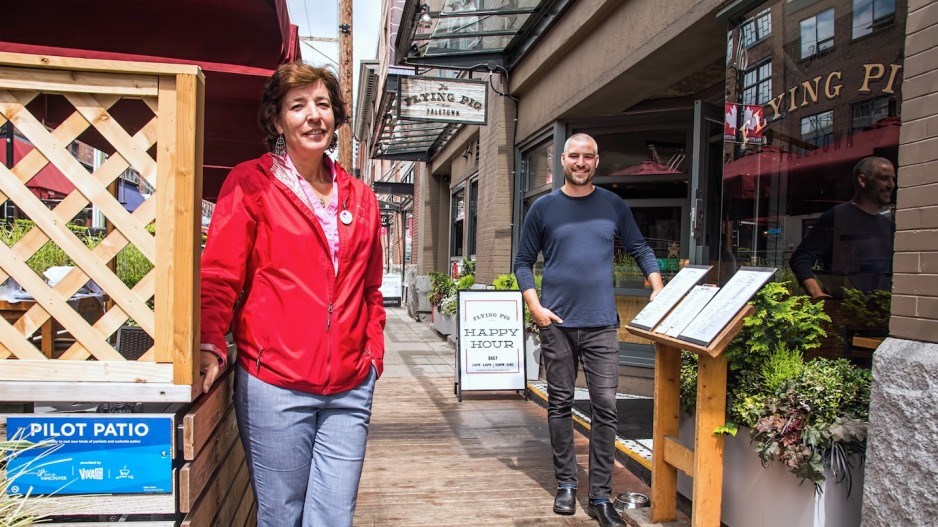New patios opening in Vancouver could be a sign that long-held concerns the city and B.C.’s Liquor Control and Licensing Branch (LCLB) have about outdoor patios separated by a sidewalk from restaurants are diminishing.
Four such patios are operating under a three-year pilot project that the city launched in 2017. Another three have city approval and could open by the end of the summer.
All the patios are different from what the city describes as unlicensed “parklets” – public spaces built on roads and financed by the city and nearby businesses.
The new licensed patios separated from restaurants by sidewalks also require removal of some parking spaces, but they are designated to specific restaurants that finance the bulk of their construction. City fees for the downtown restaurant patios are $155.50 per square metre, or the same as if they were on city property adjacent to the restaurants.
The four establishments now operating licensed patios across sidewalks are:
- Pumpjack Pub on Davie Street;
- Flying Pig on Hamilton Street;
- Bao Down on Powell Street; and
- Stepho’s Souvlaki Greek Taverna on Davie Street.
The city would not reveal the locations of the other three patios that it has approved to open later this summer.
Critics, such as Urbanics Consultants Ltd. analyst Sebastian Zein, say that the city should have been permanently approving this kind of patio for years.
“I’m not sure why we’re going so slowly here,” he told Business in Vancouver. “Generous patio space is good for urban life in Amsterdam. It’s good for urban life in Toronto, and it’s certainly good here, too.”
The initiative is important for restaurant owners because they say patios help them attract customers in summer who would go elsewhere if their restaurants had no patios. They add that the average cheque size per person is usually higher for patrons on patios, in part because patio customers often stay longer and order more drinks during hot summer weather.
History of regulation
The city and the LCLB for decades refused to allow restaurant owners to have patios that required restaurant servers to leave licensed premises to cross unlicensed sidewalks to get to licensed patios.
That changed in a one-off pilot project in 2013, when the city allowed serial restaurateur Sean Heather to open the city’s first curbside patio at his short-lived Rainier Provisions restaurant at the corner of West Cordova and Carrall streets.
Heather told BIV that his patio was open for a few months that summer but that it was not viable because LCLB inspectors required him to designate at least one staff member to be on the patio at all times when the patio was open.
“They didn’t want someone to cycle by the patio and take someone’s beer,” Heather said.
B.C.’s Ministry of Attorney General told BIV in an email that this situation has changed.
“There may be a requirement for servers to be staffed on the patio, but this is based on the unique circumstances of the application and not a general rule,” the ministry said. “Every patio proposal and establishment layout is assessed to ensure there is proper line of sight from liquor service bars throughout the service areas.”
Vancouver went without any curbside patios until late 2017, when the Flying Pig signed an agreement with the city that enabled it to open one at its Hamilton Street bistro in Yaletown in spring 2018.
Flying Pig’s head office administrator, Russ Jahns, told BIV that the patio operates mostly in the summer, although the company installed a portable fireplace during the winter to make the patio comfortable for guests who were waiting to sit at inside tables.
The restaurant’s 20-seat patio is packed for much of the day every day, he said, and the restaurant has recouped the approximately $10,000 it spent to build and furnish the area.
City money helped build the patio platform and a raised boardwalk area on the sidewalk, while the Flying Pig financed the rest.
“The process was a bit of a challenge because the entire system had to be made up as we went along,” said Jahns.
LCLB inspectors had to approve the patio but Jahns added that the Flying Pig did not need to pay for any special licence to operate.
Business advocates, such as Yaletown Business Improvement Association executive director Annette O’Shea, are thrilled with how the curbside patios are adding vibrancy to neighbourhoods in locations where they otherwise would not fit.
Many restaurants have fire hydrants, for example, or manhole covers near their entrances. City staff consider those obstacles as being insurmountable hurdles for restaurateurs who want patios adjacent to their buildings.
Businesses and residents near the Flying Pig also supported the restaurant’s application, O’Shea said, despite the proposal requiring three parking spaces to be removed.
The Flying Pig’s patio approval came mere months before O’Shea’s organization vocally opposed a city initiative to remove 75 Yaletown parking spaces to create space for fire trucks – a battle that ended in a compromise.
“We’re not opposed” to patios on streets that remove parking spaces, she said. “I’d love to see some on Homer Street. I think the situation on Hamilton and Mainland streets is that we’ve lost too much parking, and I think there would be no support [for such patios], but it would be great to see some on Pacific Boulevard or on Homer Street.”
The city has 280 large patios that are adjacent to restaurants. That is down from 317 in 2012, but up from 267 in 2008, according to city statistics.
gkorstrom@biv.com
@GlenKorstrom



